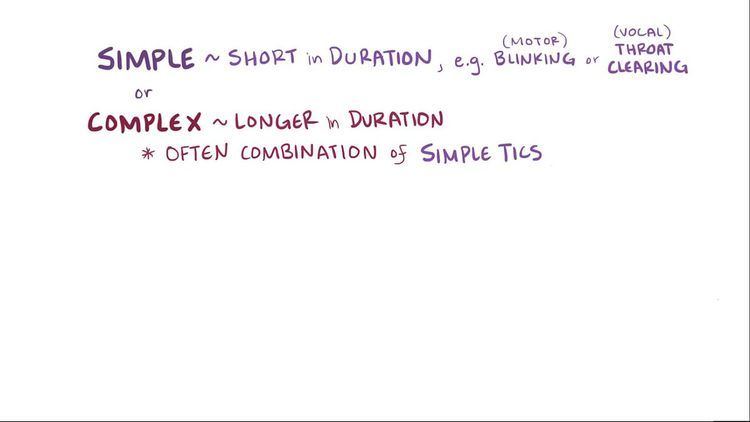Tic disorders is defined in the Diagnostic and Statistical Manual of Mental Disorders (DSM) based on type (motor or phonic) and duration of tics (sudden, rapid, nonrhythmic movements). Tic disorders are defined similarly by the World Health Organization (ICD-10 codes).
ICD10 diagnosis codes are:
F95.0 Transient tic disorderF95.1 Chronic motor or vocal tic disorderF95.2 Combined vocal and multiple motor tic disorder [Gilles de la Tourette]F95.8 Other tic disordersF95.9 Tic disorder, unspecifiedIn the fourth revision of the DSM (DSM-IV-TR), tic disorders were classified as follows:
Transient tic disorder consisted of multiple motor and/or phonic tics with duration of at least 4 weeks, but less than 12 months.Chronic tic disorder was either single or multiple motor or phonic tics, but not both, which were present for more than a year.Tourette syndrome was diagnosed when both motor and phonic tics were present for more than a year.Tic disorder NOS was diagnosed when tics were present, but did not meet the criteria for any specific tic disorder.DSM-5 was published in 2013, updating DSM-IV-TR, which was published in 2000. The following changes were made:
The word stereotyped was removed from tic definition: stereotypies and stereotypic movement disorder are frequently misdiagnosed as tics or Tourette syndrome. The definition of tic was made consistent for all tic disorders, and the word stereotyped was removed to help distinguish between stereotypies (common in autism spectrum disorders) and tic disorders.Provisional tic disorder replaced transient tic disorder: because initially presenting tics may eventually be diagnosed as chronic tic disorder or Tourette's, transient can only be defined in retrospect and is not very useful to the clinician. The term provisional "satisfies experts with a more systematic epidemiological approach to disorders", but should not imply that treatment might not be called for.Differentiation of chronic motor or vocal tic disorder: DSM-5 added a specifier to distinguish between vocal and motor tics that are chronic. This distinction was added because higher rates of comorbid diagnoses are present with vocal tics relative to motor tics.Stimulant use as a cause removed: there is no evidence that the use of stimulants causes tic disorders.New categories, Other specified and Unspecified: for tic disorders that result in significant impairment to the individual yet do not meet the full criteria for other tic disorders. The new categories account for tics with onset in adulthood, or tics triggered by other medical conditions or illicit drug use.The fifth revision of the Diagnostic and Statistical Manual of Mental Disorders (DSM-5), published in May 2013, classifies Tourette's and tic disorders as motor disorders listed in the neurodevelopmental disorder category.
Tic disorders, in order of severity, are:
307.20 Other specified tic disorder (specify reason)307.20 Unspecified tic disorder307.21 Provisional tic disorder307.22 Persistent (chronic) motor or vocal tic disorder (specify motor or vocal)307.23 Tourette's disorderTics should be distinguished from other causes of tourettism, stereotypies, chorea, dyskinesias, myoclonus, and obsessive-compulsive disorder.
Education, and a "watch and wait" strategy, are the only treatment needed for many, and the majority of individuals with tics do not seek treatment; treatment of tic disorders is similar to treatment of Tourette syndrome.
Tic disorders are more common among males than females.
A large, community-based study suggested that over 19% of school-age children have tic disorders; the children with tic disorders in that study were usually undiagnosed.
As many as 1 in 100 people may experience some form of tic disorder, usually before the onset of puberty. Tourette syndrome is the more severe expression of a spectrum of tic disorders, which are thought to be due to the same genetic vulnerability. Nevertheless, most cases of Tourette syndrome are not severe. Although a significant amount of investigative work indicates genetic linkage of the various tic disorders, further study is needed to confirm the relationship.

